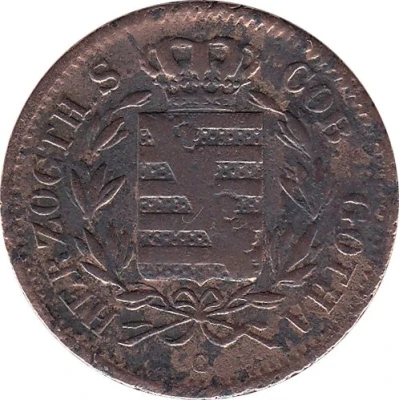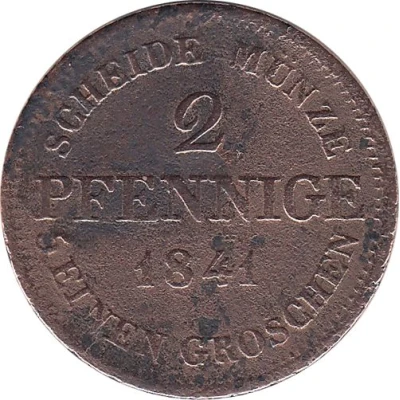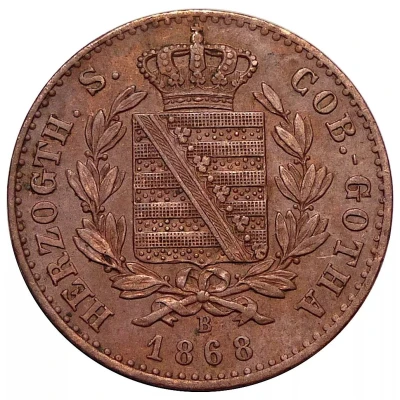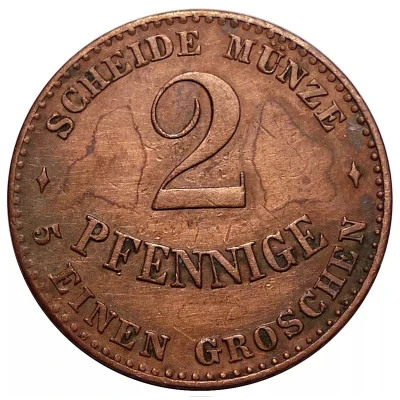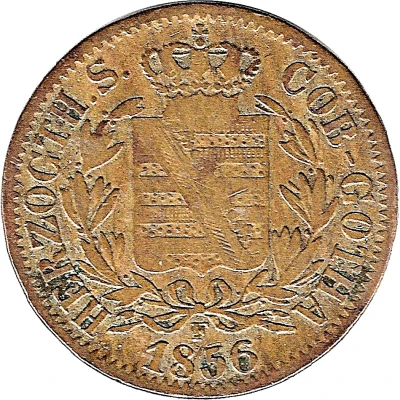
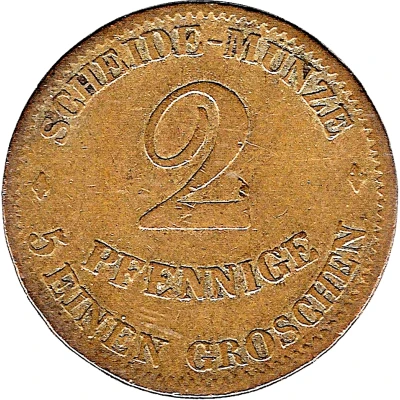

© noumea
2 Pfennige - Ernest II
| Copper | 2.98 g | 20 mm |
| Issuer | Duchy of Saxe-Coburg and Gotha (German States) |
|---|---|
| Duke | Ernest II (Ernst II) (1844-1893) |
| Type | Standard circulation coin |
| Years | 1847-1856 |
| Value | 2 Pfennige = ⅕ Groschen (1⁄150) |
| Currency | Thaler (1841-1870) |
| Composition | Copper |
| Weight | 2.98 g |
| Diameter | 20 mm |
| Thickness | 1.3 mm |
| Shape | Round |
| Technique | Milled |
| Orientation | Medal alignment ↑↑ |
| Demonetized | Yes |
| Updated | 2024-10-05 |
| Numista | N#34987 |
|---|---|
| Rarity index | 31% |
Reverse
Denomination.
Script: Latin
Lettering:
SCHEIDE-MÜNZE
2
PFENNIGE
5 EINEN GROSCHEN
Edge
Plain
Comment
Saxe-Coburg and Gotha (German: Sachsen-Coburg und Gotha), or Saxe-Coburg-Gotha (German: [saks ˈkoːbʊɐ̯k ˈɡoːtaː]), was an Ernestine, Thuringian duchy ruled by a branch of the House of Wettin, consisting of territories in the present-day states of Thuringia and Bavaria in Germany. It lasted from 1826 to 1918. In November 1918, Charles Edward, Duke of Saxe-Coburg and Gotha, was forced to abdicate. In 1920, the northern part of the duchy (since 1918 the Free State of Saxe-Gotha; culturally and linguistically Thuringian) was merged with six other Thuringian free states to form the state of Thuringia: Saxe-Weimar-Eisenach (until 1918 a grand duchy), Saxe-Altenburg and Saxe-Meiningen (until 1918 duchies), Schwarzburg-Rudolstadt and Schwarzburg-Sondershausen (until 1918 principalities), as well as the People's State of Reuss (until 1918 the principalities of Reuss-Gera and Reuss-Greiz). The southern part of the duchy (since 1918 the Free State of Coburg; culturally and linguistically Franconian), as southernmost of the Thuringian states, was the only one which, after a referendum, became part of Bavaria.The name Saxe-Coburg-Gotha also refers to the family of the ruling House of Saxe-Coburg and Gotha, which played many varied roles in the dynastic and political history of Europe in the 19th and 20th centuries. In the early part of the 20th century, before the First World War, it was the family of the sovereigns of the United Kingdom, Belgium, Portugal, Bulgaria, and Saxe-Coburg-Gotha. In 1910, the Portuguese king was deposed, and the same thing occurred in Saxe-Coburg-Gotha in 1918 and in Bulgaria in 1946. As of 2016, branches of the family still reign in Belgium, the United Kingdom, and the other Commonwealth realms. The former Tsar of Bulgaria, Simeon II (reigned 1943–46), kept his surname while serving as the Prime Minister of Bulgaria from 2001 to 2005.
Interesting fact
The 2 Pfennige coin from the Duchy of Saxe-Coburg and Gotha, minted during the reign of Ernest II (1847-1856), features an interesting design element - a crowned shield with the coat of arms of the duchy, surrounded by a wreath of oak leaves. This design was a common motif in coins of the German States during that period, symbolizing the unity and strength of the region.
Price
| Date | Mintage | VG | F | VF | XF | AU | UNC |
|---|---|---|---|---|---|---|---|
| 1847 F | 130000 | - | - | - | - | - | - |
| 1851 F | 125000 | - | - | - | - | - | - |
| 1852 F | 146000 | - | - | - | - | - | - |
| 1856 F | 600000 | - | - | - | - | - | - |
Values in the table are based on evaluations by sales realized on Internet platforms. They serve as an indication only for 2 Pfennige - Ernest II 1847-1856 coin.
